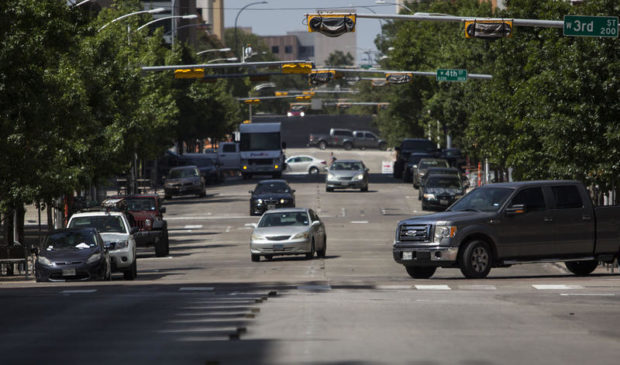Newsletter Signup
The Austin Monitor thanks its sponsors. Become one.
Most Popular Stories
- Latest State of Downtown report shows the city core’s businesses and housing are in transition
- Cap Metro to shelve 46 new electric buses for a year after manufacturer bankruptcy
- Jesús Garza disputes allegation that he violated city ethics rule
- Mobility Committee hears public concern regarding expansion of MoPac
- Council gives first reading OK to major development on tiny slice of land
-
Discover News By District

Another downtown Austin street goes two-way. Studies tell us that’s good.
Friday, July 20, 2018 by Audrey McGlinchy, KUT
For 68 years, drivers on Colorado Street in downtown Austin could go only one way: south.
But as of today, that one-directional road officially goes two ways for cars. It’s the hip thing to do.
“This is absolutely a trend,” said Billy Riggs, assistant professor of management at the University of San Francisco. Riggs said more cities have been converting one-way streets to two-way streets over the past two decades, but that more recently the trend has, well, picked up speed.
Drivers Forced To Pay Attention
One reason is that two-way streets tend to be safer – for everyone.
“It comes across as counterintuitive, right?” Riggs said. “Well, if pedestrians only have to look one direction, that’s a safer environment for them. But what we’re finding is that the performance of one-way streets actually facilitates faster-moving traffic.”
In a study published in 2015, Riggs and a colleague looked at streets in Louisville, Kentucky. They compared the number of car collisions on four streets – two one-way, two two-way – in downtown Louisville. The one-way streets had between four and five car crashes per month, while the two-way streets had closer to three. On the streets that were converted to two-way, the number of monthly crashes fell at a rate as high as 60 percent.
Riggs said the difference is that two-way streets, with the potential threat of oncoming traffic, force drivers to pay more attention.
“Creating an uncertain environment is the best thing we can do for you as a driver to get you to drive safer,” Riggs said.
Lee Austin, a traffic engineer with the city, agreed.
“When you have oncoming traffic, and you’re a little nervous about what they’re doing, you’ll go much slower than if you have a one-way street and you have no possible conflicts. People tend to go a lot faster,” she said.
Two-Way Streets Are Retro
By going two-way, Colorado Street is getting back to its roots – albeit, more slowly than anticipated.
According to the Austin American-Statesman, Colorado used to be a two-way street. But in 1950, it became one-directional – along with Brazos, Seventh and Eighth streets.
It created, at first, some issues.
“Traffic went north on streets marked one-way south,” a Statesman reporter wrote in an article with the headline, “One-Way Streets Result in Carnival of Confusion.”
“There was a crazy-quilt pattern of parking and lots of stopping, backing and looking for directional signs,” the article said.
In 1972, there was another wave of one-way conversion when Fifth and Second streets, along with what is now Cesar Chavez Street, went down to one direction.
Austin said these conversions chart a change in thinking.
“You can look at developments from the ’70s, and we totally prioritized the car, and we didn’t prioritize pedestrians and we didn’t prioritize bicycles,” she said. “There definitely has been a change in thinking that we want downtown to be a livable environment where you feel safe and comfortable to walk and bike.”
A plan approved by City Council in 2011 called for converting more one-way downtown streets to two-way roads, including Seventh, Eighth and Ninth streets and San Jacinto Boulevard.
“(But) we don’t have any specific next targets yet,” Austin said.
This story was produced as part of the Austin Monitor’s reporting partnership with KUT. Photo by Gabriel C. Pérez/KUT.
The Austin Monitor’s work is made possible by donations from the community. Though our reporting covers donors from time to time, we are careful to keep business and editorial efforts separate while maintaining transparency. A complete list of donors is available here, and our code of ethics is explained here.
You're a community leader
And we’re honored you look to us for serious, in-depth news. You know a strong community needs local and dedicated watchdog reporting. We’re here for you and that won’t change. Now will you take the powerful next step and support our nonprofit news organization?








